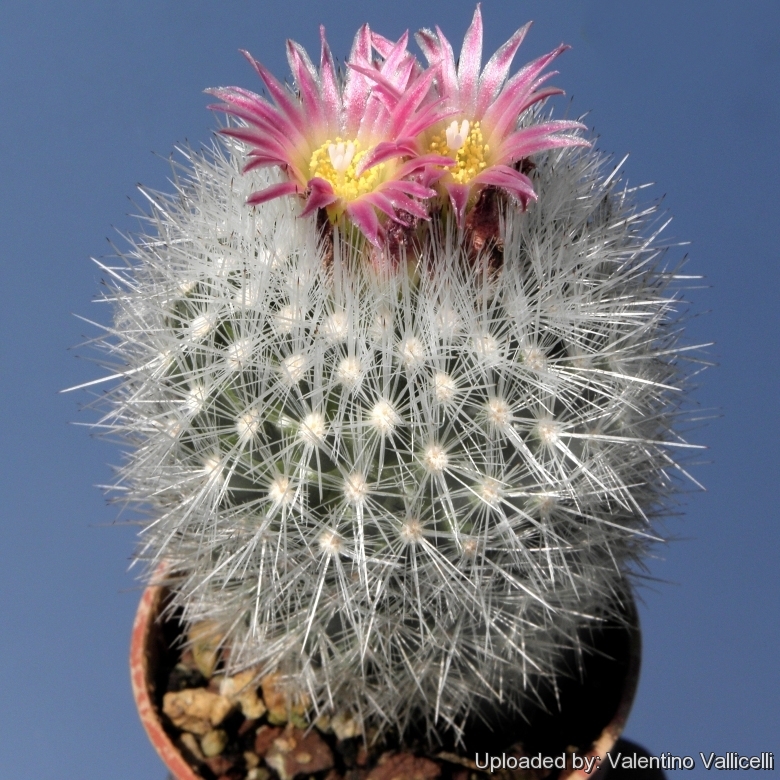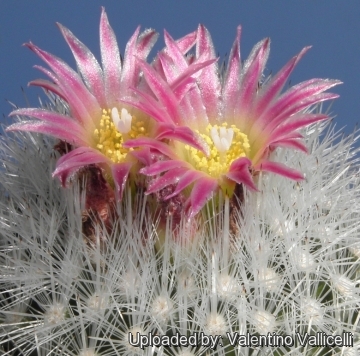




Your support is critical to our success.

Origin and Habitat: Southeastern Coahuila, in a small area between Parras, General Cepeda, Cinco de Mayoa and Santa Victoria, Mexico.
Altitude: 1900-2200.
Habitat: It grows in hill slopes on rocky outcrops.
Synonyms:
- Escobaria laredoi (Glass & R.A.Foster) N.P.Taylor
- Coryphantha laredoi Glass & R.A.Foster
Escobaria laredoi (Glass & R.A.Foster) N.P.Taylor
Cact. Succ. J. Gr. Brit. 41: 20. 1979
Synonymy: 3
- Escobaria laredoi (Glass & R.A.Foster) N.P.Taylor
- Coryphantha laredoi Glass & R.A.Foster
- Escobaria rigida Backeb.
Description: Escobaria laredoiSN|10253]]SN|10253]] is a very showy cactus species with stems densely covered with pure white spines and contrasting purple flowers in spring.
Habit: It is a low growing perennial stem-succulent solitary or many-stemmed, often forming large, compact clusters.
Stems: Upright, spherical to egg shaped or club shaped, 4-4,5 cm acrross.
Tubercles: Erect, 10-12 mm long, fissure extending to the base.
Central spines: 4-5, glassy-white (occasionally with a dark tip), 11-14 mm long, needle-like, stiff, straight spreading to erect.
Radial spines: ± 33, glassy-white, 6-12 mm unequal, radiating, stiff, straight or slightly curved.
Flowers: Small, bright lavender to magenta, 1,5-1,7 cm long, 0,8-1 cm acrross at full anthesis.
Fruits: Pinkish lavender to pale green, 1,2-1,4 cm long, sometimes with a few vestigial scales.
Bibliography: Major references and further lectures
1) Edward Anderson “The Cactus family” Timber Press, Incorporated, 2001
2) James Cullen, Sabina G. Knees, H. Suzanne Cubey "The European Garden Flora Flowering Plants: A Manual for the Identification of Plants Cultivated in Europe, Both Out-of-Doors and Under Glass" Cambridge University Press, 11/Aug/2011
3) David R Hunt; Nigel P Taylor; Graham Charles; International Cactaceae Systematics Group. "The New Cactus Lexicon" dh books, 2006

Escobaria laredoi Photo by: Valentino Vallicelli

Escobaria laredoi Photo by: Valentino Vallicelli
Cultivation and Propagation: Escobaria laredoiSN|10253]]SN|10253]] is a clustering species that readily builds up into a cluster of stems smothered by bright white spines, further decorated by purple pink blooms, it doesn't require any special treatment. If grown correctly, it will reward the grower with generous displays of flowers.
Growth rate: It is a relatively rapidly growing species. It offset from the base and can fill a 25 cm pot in just a few years given the best conditions.
Soils: It likes very porous standard cactus mix soil with little organic matter (peat, humus).
Repotting: Repotting every 2-3 years. For best results, use a shallow pot filled with very porous compost, and only use the smallest diameter pot that will accommodate the plant. Use pot with good drainage.
Watering: Water regularly in summer, but do not overwater. Its roots are easily lost in pots that stay damp for any length of time. Keep dry with ample airflow in winter. In the rest period no high atmospheric humidity!! Care must be taken with watering as they tends to become swollen and untidy in growth habit if given too much water and shade.
Fertilization: During the growing season enrich the soil using a fertilizer rich in potassium and phosphorous, but poor in nitrogen, because this chemical element doesn’t help the development of succulent plants, making them too soft and full of water.
Hardiness: It is quite frost resistant if kept dry, hardy as low as -5° C. However some warmth throughout the year will increase the grower's success (minimum 5° to 8°C during rest season).
Sun Exposure: Outside bright sun, filtered sunlight or afternoon shade, inside it needs bright light, and some direct sun. High levels of light are needed to flower and for good spine development. It can be sunburned if moved from shade/greenhouse into full sun too quickly.
Uses: It is an excellent plant for container growing. It always looks good and stays small. It look fine in a cold greenhouse and frame.
Pests & diseases: It may be attractive to a variety of insects, but plants in good condition should be nearly pest-free, particularly if they are grown in a mineral potting-mix, with good exposure and ventilation. Nonetheless, there are several pests to watch for:
- Red spiders: Sensitive to red spider mite. Overhead watering is helpful in controlling mites.
- Mealy bugs: Occasionally mealy bugs they develop aerial into the new growth among the wool with disfiguring results, but the worst types develop underground on the roots and are invisible except by their effects.
- Scales: Scales are rarely a problem.
- Rot: Rot it is only a minor problem with cacti if the plants are watered and “aired” correctly. If they are not, fungicides won't help all that much.
Propagation: Direct sow after last frost or (usually) or division . Seeds germinate in 7-14 days at 21-27° C in spring, remove the glass cover gradually as the plants develops and keep ventilated, no full sun for young plants! The seedlings should not be disturbed until they are well rooted, after which they can be planted separately in small pots. Cuttings: wait until the offsets that appear at the base of old clustered specimens are 1/3 the size of the parent and then detach and plant. Cuttings will take root in a minimum temperature of 20° C (but better in hot weather). Cuttings of healthy shoots can be taken in the spring and summer. Cut the stem with a sharp, sterile knife, leave the cutting in a warm, dry place for a week or weeks (depending on how thick the cutting is) until a callus forms over the wound. Once the callus forms, the cutting may be inserted in a container filled with firmed cactus potting mix topped with a surface layer of coarse grit. They should be placed in the coarse grit only; this prevents the cut end from becoming too wet and allows the roots to penetrate the rich compost underneath. The cuttings should root in 2 to 6 weeks.
| Your Actions | |
|---|---|
| Back to Escobaria index | |
| Back to Cactaceae index | |
 |
Back to Cacti Encyclopedia index |
Privacy stantement - Terms and conditions - How to cite - About us - Feedback - Donate



